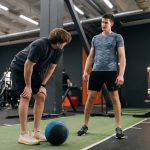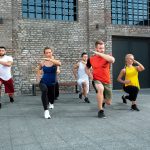
In holistic exercise, the focus rests not on isolating a specific muscle or body part, but rather on strengthening all the muscles in the body together. It takes into consideration the interconnectedness of each muscle group, and how they all work together to create/promote movement, balance and stability. Read on to learn ways trainers can integrate holistic workouts into their current programs, helping clients attain their ideal fitness levels.
Encouraging Holistic Adaptations
This approach to weightlifting began gaining popularity over recent years for many good reasons. Holistic weight training can help a client overcome the disconnects between muscles that can occur when one group of muscles becomes stronger than another group; as a result, they can no longer work together properly. Thus, a holistic approach to weight training helps the body adapt to muscle group coordination, an aspect crucial for bodybuilding.
When training holistically, it soon becomes apparent that the weaker muscles limit overall growth; as such, they must work harder to keep up with the other muscle groups. For example, when executing a lat pulldown as part of back training, the forearms typically get sore because the body relies on them to hold the bar. Therefore, weak forearms will limit how much strength the back can achieve. A holistic training approach means the forearms get hit first and hardest, and need to grow in order to hold more weight, thereby allowing the lats to progress.
Similarly, a chest machine will build strength in the pectoral muscles only. A more holistic approach would opt instead for push -ups, which work a variety of muscles while still focusing on the chest, including the lower back, core and legs. Cultivating muscle in this manner fosters a more balanced and aesthetically pleasing look, while also providing overall strength for use in daily life.
The Muscle Cell Itself
The difference between “exercising” and “training” lies in having a plan. The plan to engage in holistic training simply means working to include all different parts of the muscle cell.
No single mode of training can adequately force adaptive developments in all parts of the muscle cell, given its intricate nature. If only one element of the muscle cell gets trained (for example, in a workout focusing solely upon hypertrophy), other parts of the cell remain unchanged after training. Therefore, in order to maximize muscle cell size, one must make use of a variety of different stressors (stimuli), and in sufficient amounts, so as to activate the entire cell. This embodies the basic idea of holistic training: looking at the whole cell rather than just parts of it.
Activated by strength training, satellite cells can provide additional muscle cell nuclei and thereby improve muscle function. These cells contribute to muscle growth and repair, as nuclei control protein synthesis in the muscle fibers. When muscles undergo hypertrophy and activate the satellite cells, muscle fibers increase in size due to the addition of structural proteins.
Taking Advantage of All Possible Growth
A seasoned bodybuilder’s muscle cells typically measure around 50% bigger than before the individual ever started training. While impressive, consider the premise that holistic training may potentially increase this value to 70%.Sadly, the average single-minded bodybuilder tends to leave much of this potential size “on the table”. With holistic programming, the parts of the muscle cell that contribute most to overall size will receive the bulk of the training.
Savvy trainers can help their clients benefit by mixing a variety of techniques into their training programs. A holistic approach can take the body past simply accruing lean muscle mass, and encourage fat-burning, power and even dexterity. A well-designed holistic program will include some high repetitions, low reps, long/slow reps and fast explosive reps. Sometimes trainers incorporate all of these aspects into a single “working the whole muscle cell” training session.
Fitness experts consider holistic training day an ultra -high intensity session. For this reason, trainers will only include these types of programs every 7-10 days. This workout, typically performed straight through from exercise to exercise in one giant set, consisting of 10-12 sets, allows no rest periods. Rather, the client only takes a rest break upon completion of the full giant set. The rest interval can last from 3-5 minutes, depending on the fitness level of one’s client. Then, he engages in a second giant set, followed by another appropriate rest interval.
Choosing a Method of Holistic Training
While we can probably come up with any number of variations on the theme of working out the body in a truly holistic fashion, experts generally agree on 3 basic approaches, as outlined below:
- Rotating Cycle
This application involves changing one’s training style periodically. Fitness guru Neil Hill utilizes three cycles over three weeks: Week 1 focuses on heavy compound exercises; Week 2 sticks to
moderate-weight compound and isolation exercises; and Week 3 hones in on high reps. Holistic cycling encourages a trainer and client to compartmentalize training into periods of 1-4 weeks, with each segment devoted to a different workout approach.
- Staggered Split
This mode allows for changing up one’s training style for every workout. The easiest way to accomplish this involves staggering the split such that body parts go through the same style rotation but on different weekly schedules. For example, a client might do a power workout for legs one day and a high-rep session for back the next day. Then the next week this gets reversed. The sample staggered split listed below includes a different workout style for every body part over the course of four weeks. (In this sample split, HIT = high intensity; high rep = 15 to 25 reps; power = four to eight reps; moderate =eight to 12 reps.)
| Days | Body Part | Week 1 | Week 2 | Week 3 | Week 4 |
| Monday | Quad/Hams | HIIT | High Rep | Power | Moderate |
| Tuesday | Chest/Triceps | High Rep | Power | Moderate | HIIT |
| Thursday | Back/Biceps | Power | Moderate | HIIT | High Rep |
| Friday | Shoulders | Moderate | HIIT | High Rep | Power |
- Advanced Holistic Workout
Advanced bodybuilders often go so far as to change training styles from exercise to exercise, or even from set to set. As with the cycle and split holistic methods, this approach requires quite a bit of forethought and planning. The personal trainer, together with his client, can plot out sessions wherein one style complements another, and all of the styles taken together prove stronger than any one individually. This method means that a client can focus on more than one goal at once, such as speed, power, muscle size, and functional ability.
A sample leg routine might begin with plyometrics (box jumps, explosive box squats), progressing to moves of greater intensity (leg extensions, leg presses), then exhausting the muscles with high reps (leg adductions, hack squats) and, for those with the space and equipment, ending with a functional exercise (sled pushes). As you can see, this quickly evolves into a session more arduous than that engaged in by the novice lifter.
Incidentally, cardiovascular exercises can also morph into holistic sessions. Clients can utilize more than one machine in the same workout, and/or incorporate non-mechanical activities such as sprint intervals, swimming, hitting the heavy bag, playing basketball, or using an agility ladder. Such a format works well for a client who participates in other activities besides bodybuilding, such as football, basketball, track and field or kickboxing.
Swim Spas Encourage Holistic Training
The advent of swim spas for home use has provided us with a perfect example of a holistic workout. Swimming builds strength in the arms and legs, the primary muscle groups utilized in this sport. However, upon closer inspection of the bodies of aquatic Olympians, one can observe that all top swimmers have powerful back muscles and broad shoulders, the other key parts of the body utilized and required in every swimming stroke. To achieve status as a superb swimmer, the body requires the complete training package.
Swim spas, as opposed to regular recreational or even lap-swimming pools, boast longer lengths as well as powerful jets, allowing a swimmer to engage in full body, holistic strength training with these added benefits. The power emanating from the jets enables the user to effectively swim in the same location, while the jets’ strength provides genuine resistance. This resistance works all of the aforementioned muscles.
Stress and Stimuli for Growth
As discussed previously, holistic training, which considers the entire muscle cell as well as its environment, involves a variety of stressors. These include mechanical tension, metabolic stress, and muscle damage. Here we list examples of these various stimuli:
- Metabolic Stress:
This occurs when the muscle fibers get subjected to intense exercise, leading to a buildup of metabolic byproducts and oxygen deprivation. Training protocols including high volume and short rest periods tend to increase metabolic stress.
- Muscle Damage:
The microscopic tearing of muscle fibers, which triggers a repair and growth response. Such workouts incorporate exercises which elicit a high degree of muscle fiber damage, such as eccentric (lowering) movements.
- Mechanical Stress:
Using a variety of exercises and rep ranges, strength training targets different muscle fibers to induce mechanical stress.
Considerations When Designing Holistic Workouts
As with any training program, keeping track of the finer points of weightlifting merits close attention when training in a holistic fashion. In the case of the aforementioned advanced holistic training, these points take on even more importance, due to its rigorous nature.
Trainers should keep a careful eye on their clients’ form throughout all of the exercises. Maintaining proper form not only maximizes the effectiveness of the move, but also helps avoid injury.
The theory of progressive overload comes into play here as well. Within the working parameters of a holistic regimen, gradually increasing the intensity, frequency and volume of training help ensure continued goal-oriented progress.
Finally, the trifecta of rest, recovery time and nutrition reigns supreme in holistic training. These elements support muscle growth and repair.
Take-home Message
By incorporating a plethora of styles and techniques, holistic training can keep clients’ enthusiasm high as they begin to see progress in a variety of areas. The variation of movements/stressors helps improve overall functional fitness. When executed properly, holistic strength training can lead to greater gains in muscle hypertrophy, simply by targeting different aspects of muscle cell physiology. Training for strength, size, and explosive power, when woven together, will create a holistic training program that can foster a heightened feeling of wellbeing.
A note to competitive bodybuilders: holistic training tends to sculpt muscles without causing excess bulk or loss of flexibility. This may not necessarily align with the outcome desired by many athletes. However, sometimes long-term balance and overall health can outweigh short-term gains like trophies and medals.






